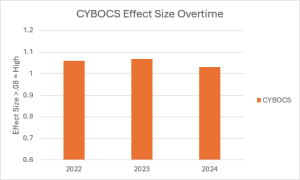Day to day, it can be easy to lose sight of the long reaching impact of the work done at Rogers, but something as simple as a heartfelt note can put it all back into perspective.
“Our team members are passionate about helping people, and they want to know the care they are providing is having a significant impact,” says Heather Jones, PhD, vice president of clinical services. “I want people to see these positive outcomes and be reminded of and understand the impact they are having on our patients’ lives.”
Such outcomes are perhaps no clearer than in a recent message from a father of a Rogers’ patient.
“The past two years have come with a lot of heartache and tears,” he writes. “The person [my son] is now compared to where he was, quite frankly, is impossible to put into words.”
John wrote to Rogers the day before his 14-year-old son was discharged after spending three months in residential care. He began treatment at a clinic in another state, and John credits the team there for knowing to escalate his son’s care to a higher level as well as for giving him a seed of hope.
“I feel blessed that the path led [here],” John says. “Let me take a moment to mention by name some of the incredible staff in who cared for my son: Dr. Butchart, John Widish, behavioral therapists Joey and Allison, educational therapist Mary, nurses Molly and Mary Beth, and the many people I did not mention, including those I have never met, but [my son] will never forget.”
“One thing I love to see as a result of this feedback is how well our teams work with each other across a national organization,” Dr. Jones says. “It is one of the most rewarding parts of my job to see our teams working together to help families like this. We helped this young man experience life-changing improvements and a reduction in his OCD symptoms that had been plaguing him and his family for years, and it’s amazing.”
Dr. Jones says success is clear in the numbers, too.
Using the Children’s Yale-Brown Obsessive Compulsive Scale (CY-BOCS), a graph below shows a consistent and high measure of treatment effectiveness across 2022, 2023, and 2024 for children and adolescents treated in residential, PHP, and IOP levels of care.

“Our commitment to continuous improvement has enabled us to transform our delivery of evidence-based interventions while maintaining high standards of care,” Dr. Jones says. “This demonstrates our ability to adapt to changing needs while preserving the core principles of our treatment approach.”
Progress requires moving forward without losing hold of what brought success in the first place.
“We are pairing legacy with innovation,” Dr. Jones says. “We have long been known for providing specialty care and having exceptional patient outcomes, and that is not changing. We are an organization that is going to innovate into the future and focus on what our patients need and want.”
Dr. Jones says that requires some changes in the System, including moving away from isolated exposure time in our clinics and moving toward bringing people together for treatment. She adds that togetherness is especially important to combat loneliness, highlighting a U.S. Surgeon General advisory about the dangers of isolation.
“We have moved toward a more community-based model where patients are being treated and they’re doing their exposure work together,” says Dr. Jones. “Patients are getting more consistent time with clinicians in the room to help them with their exposures. It makes a huge difference in keeping patients on task and tailoring exposures in real-time to ensure patients are challenged and engaged throughout their exposure time.”
While Dr. Jones says it’s critical to see success in outcome metrics, it’s stories like the one from John that really stick with her.
“Usually when people are calling us, they’re at the end of their rope. They don’t know what else to do,” she says. “They’ve suffered as a family for a long time, and to see groups of people coming together for a common shared mission to help not only this family and child — but also the patients we see on an everyday basis improve and achieve greater well-being — is the most fulfilling thing for me to see.”
“I am eternally grateful for their work and dedication,” John writes.
Rogers team members are expressing gratitude and appreciation of their own after reading John’s message:
Jen Skemp, manager of Residential Operations, Residential OCD and Anxiety Adolescent: “This is ABSOLUTELY incredible!!! I am in awe of the work they continue to do each day, and I am so proud to be part of their team! They are an amazing group!! I hope you all truly understand how much you have changed his life, and that of his family. You are angels!”
Amanda Boeke, PsyD, VP of operations Campus: “This is heartwarming! We are so grateful for the staff that created this impact for the resident and their family!”
Peggy Scallon, MD, medical director: “This is incredible! Thank you so much to the entire team for providing this outstanding and life-changing care. “
Brenda Bailey, executive director of Clinical Services: “Wow—this is excellent! Truly heartwarming to read ❤.”
Jacob Plestina, MHT, OCD and Anxiety Center, Adolescent Residential Care: “This is truly incredible! I am deeply grateful to be part of a team that makes such a meaningful impact on the lives of individuals like [the patient]. His story from both [the patient] and his father is both inspiring and heartwarming, and it reinforces that Roger’s is a place where people can find the support they need. It is a privilege to contribute to an organization that values and supports everyone.”
John Widish, MSW, APSW, therapist, OCD and Anxiety Center, Adolescent Residential Care: “John’s post is emblematic of why I have such an intense passion for therapy. Here at Rogers, we receive desperate patients and families from all over the country who often feel as though they have nowhere else to turn after exhausting all other mental health options. It is hard to imagine anything more rewarding than supporting an individual develop their inner strength and resiliency to regain the life they want to live. I am grateful to be a part of their journey and a clinical team of such a high caliber. I will always remember [the patient’s] humor and fun-loving nature. When we met him, only a small piece of his personality was able to shine through the filter that was OCD. By the time he left, [the patient] was much more open, engaged, and interested in talking with others – especially his age which was a huge win for him. [The patient’s] journey reinforced the value of positive therapeutic relationships and consistent reinforcement. It was very difficult for [the patient] to overcome his OCD and he valued the positive relationships he created with team members, peers, and staff he met in the program. This connection fostered his willingness to confront and overcome his OCD that otherwise seemed impossible.”


